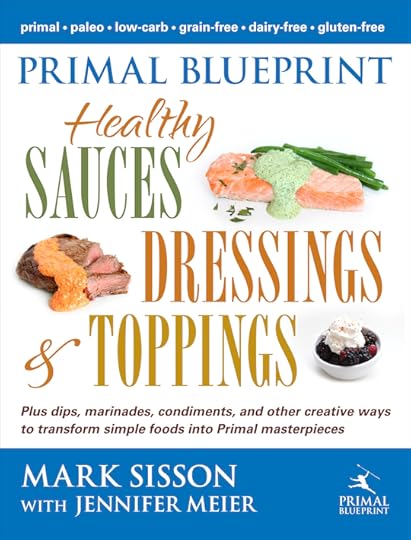Mark Sisson's Blog, page 355
December 11, 2012
Top 10 Reasons to Order Primal Blueprint Healthy Sauces, Dressings & Toppings
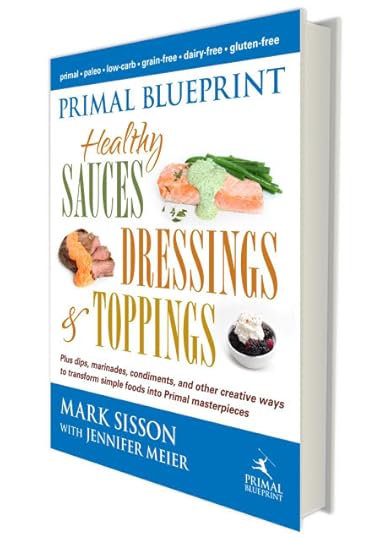
I always believe in my products. Not just in the “I believe that they’ll succeed” sense, but in the “I believe that these products serve a purpose and fulfill a need in people’s lives” sense. Frankly, that’s why I promote them, and why I’m able to do it with a clear conscience: because I know I’m making a difference (however small and localized it may be), or at least trying to make one. And so here we are, in the final hours of the Primal Blueprint Healthy Sauces, Dressings & Toppings giveaway extravaganza. (I don’t think I’ve ever used that word – “extravaganza” – before in a serious way, so I’m trying it out for a change. What do you think?) If you’ve just been putting off the order for whatever reason, here’s your cue to go order a copy. If you haven’t yet been convinced, allow me to give you a few reasons why I think you should order the book. Give them an honest appraisal; that’s all I ask.
Okay, on to the top 10 reasons why you should order the new book:
1. If you’re new to Primal and are looking for some creative dishes to kick start your new healthy lifestyle this book is for you.
You’re about to embark on a new health journey – Primal living – and that’s one of those big life changes, which tend to be overwhelming. To better assist you in the transition, why not stack the deck with every tool imaginable to help you overcome any future difficulties? Having a compendium of sauces, dressings, and toppings will ensure all these new foods you’re about to introduce into your diet stay new, stay fresh, and stay exciting for years to come. Hit the ground running, I always say. Bring a rocket-propelled grenade to a gun fight.
2. If you are already Primal but your regular, go-to, staple meals could use some updating this book provides all the tips and recipes you need.
We just went over the looming spectre of the dreaded food fatigue yesterday, and there’s no simpler, easier, or more efficient way to waylay the beast than through the application of a velvety, viscous, mouth-coating Primal sauce to whatever food is currently fatiguing you. Just try making the spicy red pepper coconut sauce next time food fatigue is hanging around the kitchen. It’s hilarious to see it freak out. It starts out cocky enough. You smash a couple cloves of garlic, chop scallions, and seed a chile and it laughs in your face, but there’s a nervous sheen to the laughter. When you pull out the blender and turn the first set of ingredients into a frothy affront to its existence, the laughter stops. And then, once the coconut milk and lemon juice comes in, food fatigue runs shrieking from the kitchen. The book is full of sauces with a similar effect on the rascally little fiend.
3. If you like what we do here on MDA, book sales make it all possible.
I love doing what I do here, every day, on this blog. The books, the supplements, the other merchandise are all great products that I truly believe in, and they’re also there so that I can keep bringing you guys daily updates and musings. Without this outlet, I’d probably go crazy. The blog work is still writing, but it’s not the same as writing a cohesive book. It’s relaxing (sort of), quicker, easier, more enjoyable. Each post is self-contained without the need to flow into the next one. Writing the blog is almost like having a break from the “real” work. Problem is, I need to do the real work to make the blog pay off. More importantly, I need people to read and support the real work to make the blog run.
4. If you like The Primal Blueprint Cookbook, Primal Blueprint Quick & Easy Meals and MDA recipes, you’ll love Primal Blueprint Healthy Sauces, Dressings & Toppings.
We’ve got a pretty good track record with recipes, if I do say so myself. The response to our cookbooks and our Saturday recipes has been hugely positive, and I’m confident you’ll like the sauces, dressings, and toppings just as much. Plus, Primal Blueprint Healthy Sauces, Dressings & Toppings was designed with all previous PB cookbooks in mind. If an older recipe already has a sauce, you’ll be able to find several in the new book that work just as well with the dish – if not better.
5. Buying a copy will help us continue to spread the word and expand the Primal movement – helping others around the world take control of their health.
As much as we relish taking control of our own health into our own hands (what a novel idea, eh?), it’s also important to give others the opportunity to do the same. And yeah, you could make the argument that the information is there for those who want it. I won’t argue with that. I’ll just say that the more copies we sell, the bigger we get and the more resources we have to continue to spread and expand the Primal movement. The bigger we get, the more this information gets “out there” so that the wider world can take a gander and, hopefully, do the same as we all have.
6. “You like a da juice!”
The classic SNL skit really doesn’t lie, does it? Although most of us aren’t lucky enough to have a quartet of mustachioed gents serving us juice and then repeatedly ensuring that we like it, we can make our own “juice” and then like it. And by juice I mean sauces, dressings, toppings, and any other concentrated edible liquids in general, which are just amazing and delicious. They provide the essence of whatever it derives from, whether it’s gyro meat with errant ‘stache hairs in it or the ingredients of your healthy dressing, in pourable form. If you like a da juice, buy the book and learn to make your own.

7. It makes a perfect holiday gift.
Everyone loves a good sauce, dressing, and topping, and yet all across the globe, refrigerator doors are lined with crusted over bottles of soybean oil ranch, bottles of “olive oil” that simply will not harden, and leftover takeout sauces that are more HFCS than anything else. People need your help. They need good sauces, and they need them quickly. Don’t let them make it into the new year without this book. With any luck, the giftee will get so excited about the book that they’ll leap up and start whipping up food, all the while calling you in to the kitchen to test all the sauces (might want to bring a spoon, just in case – what, you guys don’t carry pocket spoons?).
8. Order just a single copy and get $100 in bonuses.
For round $18 (the approximate price of one book), you get a hundred bucks worth of bonuses:
12-Month Subscription to Paleo Lifestyle E-Magazine ($35.88)
Delicious Paleo Roasts E-book from paleocookbook.com ($12)
The Modern No-Nonsense Guide to Paleo from PaleoNonPaleo.com ($15)
$10 Gift Certificate to PrimalBlueprint.com ($10)
The Primal Blueprint Audiobook (MP3) ($26.95)
Oh, yeah, and on top of that, you get a nice sauce recipe book, too. Learn how to get these bonuses here.
9. Grab three or more copies and get a plethora of additional bonuses worth $159.
For about $54, you get all this:
The Primal Blueprint “I’m an Offal Chef!” Apron ($20)
The Primal Blueprint Poster ($14.95)
The Primal Blueprint Wristband ($2.50)
$20 Gift Certificate to PrimalBlueprint.com ($20)
Paleo Lamb Recipes E-book from paleocookbook.com ($12)
12-Month Subscription to Paleo Lifestyle E-Magazine ($35.88)
Delicious Paleo Roasts E-book from paleocookbook.com ($12)
The Modern No-Nonsense Guide to Paleo from PaleoNonPaleo.com ($15)
The Primal Blueprint Audiobook (MP3) ($26.95)
Plus the books themselves. If you want to get your Christmas shopping done fast, this is the way to do it. Again, you can learn how to get all these bonuses here.
10. The special offer ends tomorrow! There’s no better time than now. In fact, there is no other time than now.
This is ultimately what it comes down to, isn’t it? There’s a good book full of helpful recipes for delicious, healthful sauces and dressings and toppings, an amazing deal that’s only available if you purchase said book(s), and a single day remaining to take advantage. In two days’ time, the book will still be there available for purchase, but none of the other stuff. If you think you might like the book somewhere down the line, why not just buy it today and get the extras? The book stands on its own, but we all like free stuff – don’t lie.
That’s what I’ve got, folks. If any of these reasons resonated with you, consider picking up a copy or three. I’d be forever grateful.
Thanks and Grok on!
Get Your Copy of Primal Blueprint Healthy Sauces, Dressings & Toppings Today!

December 10, 2012
Dear Mark: Food Fatigue Edition
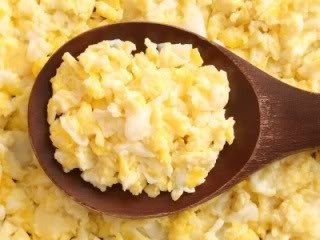 First of all, I think we can all agree that Primal food is a solid foundation of taste, nutrition, satiety, density, and volume. When you put a piece of well-cooked grass-fed steak, free of sugary salty soybean oil-infused sauces and unnecessary breading in your mouth, you appreciate that this is how meat was meant to be. When you use fresh vegetables, kale that bites back and asparagus that snaps in your mouth and cooked carrots that manage to be both tender and crispy at once, you know the goodness of produce. And these fill you up, they nourish, they enrich your life. Still, though, we humans possess the ability to perceive and appreciate a nearly infinite range of flavors and textures. Hundreds (if not thousands) of cuisines and flavors beckon, and we should probably entertain their advances. If we don’t, if we eat the same things all the time, we may run into food fatigue.
First of all, I think we can all agree that Primal food is a solid foundation of taste, nutrition, satiety, density, and volume. When you put a piece of well-cooked grass-fed steak, free of sugary salty soybean oil-infused sauces and unnecessary breading in your mouth, you appreciate that this is how meat was meant to be. When you use fresh vegetables, kale that bites back and asparagus that snaps in your mouth and cooked carrots that manage to be both tender and crispy at once, you know the goodness of produce. And these fill you up, they nourish, they enrich your life. Still, though, we humans possess the ability to perceive and appreciate a nearly infinite range of flavors and textures. Hundreds (if not thousands) of cuisines and flavors beckon, and we should probably entertain their advances. If we don’t, if we eat the same things all the time, we may run into food fatigue.
I’m probably a bad example of this, because I’m the type of guy who’d be pretty happy with just ten or so foods for the rest of my life. Still, even I like to change things up now and again. And it seems I’m not alone. This edition of Dear Mark is geared directly to you. Let’s go:
I’ve been eating eggs for breakfast everyday for years now. Now don’t get me wrong, I still love eggs, but sometimes I either don’t have time to cook eggs before leaving for work or eggs just don’t sound good. A little breakfast variety would be nice. Eggs seem like the perfect morning food (protein, fat, nutrients) but there’s only so many fried eggs I can eat. Any ideas?
Thanks, Mark,
Paul
Eggs truly are the perfect breakfast item. They feature high quality protein, animal fat, and, particularly if you have access to real pastured eggs, a micronutrient profile that puts nearly every other food to shame. Plus, eggs also provide a nice dose of cholesterol and choline, two brain-boosting nutrients that you’ll likely put to good use. Oh, sure, you could make the argument for liver or oysters as being more “nutrient-dense,” but who wants to cook up a batch of beef liver every morning? Eggs are simple and easy.
But they’re also boring, or so some people believe. Eggs are just eggs. You can scramble them, boil them, make omelets, or fry them, and not much else.
Yeah, eggs have become the quintessential breakfast food, which wouldn’t be a problem if we hadn’t backed ourselves into a corner with our preconceived notions of what constitutes breakfast. We need to expand our breakfast horizons. Breakfast needn’t be dominated by over-easy or scrambled eggs seasoned solely with salt and pepper and cooked in butter. I love eggs like that – don’t get me wrong – but some people need variety.
I would be loathe to suggest shifting your focus away from eggs for the aforementioned reasons. Instead, come up with some new variations of old favorites:
Hard-boiled eggs are handy and hardy, but the yolks can get a little chalky if you let them cook for even a half minute too long. If you’re rushing about trying to get ready for the day, you’re bound to make a mistake and overcook the eggs. The solution here, of course, is not to take up bagel eating or force IF into your life. It’s to try a soft-boiled egg. With a soft-boiled egg, the yolk stays creamy, velvety, runny and the white gets custardy. I cover cold eggs with an inch of water in a pot then bring to a rolling boil over high heat. Upon boiling, shut off the heat and cover the pot. After four minutes (three minutes if you’re starting with room temperature eggs), dump the water. I prefer peeling the eggs under cool running water while they’re still warm, but others say to plunge them in an ice bath. If you’re strapped for time, the cool water is good enough. Lately, I’ve been dusting the eggs with black pepper (lots), sea salt, and turmeric. Far superior to dry hard-boiled eggs (with less oxidation of the cholesterol to boot) and hard to mess up since, if you mess up and go over the time, you end up with pretty good hard-boiled eggs.
Other ideas?
Scrambled eggs with salt, pepper, butter, and maybe even a bit of bacon is a true classic, yes. I’ll never turn down a plate. That said, you can easily transform a humdrum plate of scrambled eggs with the addition of a couple generous tablespoons of tomato paste about midway through the scrambling process.
Turn a plate of sunny side up pastured eggs into a sweet and savory treat with a dusting of cinnamon and some coconut oil.
Or how about frittatas? Have your ingredients prepped the night before, then, when you wake up, scramble the eggs, mix it all together, and dump them in the oven before you start getting ready. By the time you’re dressed/caffeinated/presentable/etc., your egg-based breakfast will be ready.
One of my favorites on a cold (for Malibu) winter morning is a couple cups of bone broth with two or three raw eggs dropped in and allowed to cook. The white will cook fast, since it disperses through the liquid, while the yolk will remain gooey unless pricked and allowed to run. Include a handful of bitter greens and you’ve got a quick, easy breakfast on your hands.
These variations are small and often require no additional prep time, but they really and truly pay off. The resulting dishes taste better, taste different, and are arguably more nutritious than their predecessors. You maintain the ease and nutrition of an egg breakfast without succumbing to monotony. Win win.
Also, don’t limit yourself to the things I suggested. Look around for more suggestions from similar eaters. The point is that eggs are culinary blank slates that happen to be delicious on their own. Feel free to toss in some berries, bacon, sausage, sweet potato, grilled onions, or whatever else strikes your fancy, because everything goes with eggs. I’m serious – name something and I bet it goes with eggs.
The strangest thing has happened to me recently. I am a huge proponent for the Primal lifestyle and eating strategy, but I’ve recently lost my craving for meat. I’m not completely disgusted by it, but I’ve lost my drive to eat it. What should I do? Listen to my body and not eat it, or try something else?
Thanks
Jenny
First of all, I don’t think you should give up “meat.” It’s an essential part of the human diet, it’s full of highly bioavailable micronutrients, and, well, it’s just really, really good for you. However, I do think we tend to run the risk of forgetting that an animal is so much more than “meat.” A pig is not just belly and loin. A cow is not just ribeye and burger. A chicken is not just breast and wing. There are so many incredibly diverse, delicious, and nutritious parts to an animal that we do ourselves a disservice by sticking to just “meat” – and we can easily find ourselves stuck in a food rut as a result.
So, you’re going to want to diversify. Learn about all the odd cuts. Start saving and buying bones and making stock. Learn to love liver. Consider the gristly bits, the parts that need a little more time in the crockpot or braising pan to get tender: the tails, the shanks, the knuckles. These “alternative” cuts will force your hand. You’ll have to start cooking in different ways because you can’t treat a lamb shank like a sirloin steak. It just won’t work. You may also be eating too much meat, as in “lean meat.” I prefer the fattier cuts over all else. I like ribeyes rather than filets, for example. I can eat an 80/20 or 85/15 ground beef burger with a bit of salt and pepper quite happily, whereas I’ll need to dress up a 95/5 to make it palatable. There are certainly ways to dress up plain old lean meat (which usually involve adding some sort of fat or sauce), but you may just need to eat fattier cuts.
Mark,
My husband and I realized the other day that we’ve been eating nearly the exact same rotation of meals for over a year now. We rarely eat out and we take turns cooking our meals. Over time we’ve hit upon things that are easy to make and that we like so we just keep going back to them over and over and over again. Do you think there’s anything wrong with this? Should we add some variety. To be honest, it is getting a little boring. Any ideas on how to get out of our food rut are very much appreciated. Grok on!
Best,
Talia
There are theoretical benefits to a varied diet, which I’ve outlined before:
Access to a wider variety of micronutrients and phytochemicals. Think of all the various antioxidants associated with the greens, reds, yellows, purples, and oranges in fruits and vegetables. Think of how vitamin and mineral content differs between foods.
Dilution of food toxins. Food toxins usually operate in a dose-dependent manner, so keeping a variety would help keep the doses low and hormetic.
Food enjoyment. Eating the same three things is a sure path to food boredom. Eating should come with a serving of sensory enjoyment.
Those are all valid reasons to eat a varied diet, and the last one – food enjoyment – seems to be affecting you. However, a “varied diet” doesn’t necessarily mean eating South Indian one night, some obscure dish from the Thai highlands the next night, and haggis after that. It doesn’t mean working crickets into your regular diet, or camel milk, or never repeating the same meal in a month. It can mean all those things, but it doesn’t have to. Grok (and every other preindustrial culture) never had access to the amount of variety we currently enjoy, and he did okay for himself. As I mentioned earlier, I eat a pretty steady diet without constant wild excursions into other culinary realms, and I also do okay for myself on the micronutrient/phytochemical and toxin dilution front. Wild, adventurous, global variety a la Andrew Zimmern isn’t required or even necessarily optimal, so don’t get yourself down over that.
I don’t want to sound self-serving with this next part, but emails like yours are the precise reason why I decided to co-write Primal Blueprint Healthy Sauces, Dressings & Toppings . Because sometimes (most times), all you need to drastically change the character of a dish is a well-placed and poignantly-applied sauce. Sometimes the salt, pepper, olive oil, and vinegar routine gets boring to the point of making you dread and avoid your greens, while a new dressing will upregulate your intake of healthful veggies. So, Talia, I’d say that you shouldn’t stress out about food variety for variety’s sake, but you should seek to enjoy your food. You shouldn’t be miserable. You shouldn’t feel bad. And if you’re not keen on putting together an entirely new arsenal of dishes, learning a few dozen solid sauces, dressings, and toppings can keep your usual dishes feeling fresh without forcing you too far out of your comfort zone.
That’s it for today, folks. I hope I helped some people out. If you’ve got anything to add about food variety and keeping meals interesting, be sure to leave your comments below!
Get Your Copy of Primal Blueprint Healthy Sauces, Dressings & Toppings and Claim Your Bonuses Today

December 9, 2012
Weekend Link Love
 The response to Primal Blueprint Healthy Sauces, Dressings & Toppings has been fantastic, but I have one more small favor to ask. If you’ve received your copy, I would be forever grateful if you were to take a few minutes to write a quick (or long) review on Amazon and/or Barnes and Noble so that we can spread the word and progress the movement even further. Thank you!
The response to Primal Blueprint Healthy Sauces, Dressings & Toppings has been fantastic, but I have one more small favor to ask. If you’ve received your copy, I would be forever grateful if you were to take a few minutes to write a quick (or long) review on Amazon and/or Barnes and Noble so that we can spread the word and progress the movement even further. Thank you!
Research of the Week
Outgoing gorillas consistently outlive shy gorillas.
Adding fish oil to the diets of bed-ridden patients improved their immune systems and streamlined the inflammatory/healing process enough to reduce the time it took for their bed sores to heal by 25%.
Interesting Blog Posts
In case you’ve been wondering about the latest fat-busting craze to sweep the Primal world, Richard Nikoley breaks down the basics of the potato diet hack in inimitable fashion.
Over at Better Movement, Todd Hargrove compares the flawless running form of a slow-motion cheetah with the form of elite 10k meter runners. Man, check out how steady that cheetah’s head is as it lopes effortlessly across the grass. Nuts.
Media, Schmedia
That wasn’t a grizzly bear you heard out in the woods last weekend; it was Grizzly Bear. Yes, folks, it’s true: the hipsters have taken up hunting.
Even NASA astronauts are getting hip to the effects of blue light on our sleep and melatonin production. In response to rampant insomnia among spacefarers despite access to relaxation techniques, expert sleep hygiene, and the best sleep pills money can buy, NASA is dropping $11 million to revamp the lights in the US portion of the International Space Station.
Everything Else
I sure do wish we had a Toilet Culture park here in Southern California. Ah well, another reason to visit Korea.
This is what you’re “missing” by eating Primal. Jealous? I didn’t think so.
Recipe Corner
It’s probably a little cold where you are, and you may not be in Memphis, but you should still try this great recipe for Memphis style ribs.
Sure, until you realize what you’re actually looking at, the image Easy Dairy Free used looks a little like the contents of an obese zombie’s stomach, but the recipe for ragu bolognese is traditional, legit, and includes neck bones.
Time Capsule
One year ago (Dec 9 – Dec 15)
The Importance of Dreaming – It may seem as if spending several hours each night thinking that you have to take a final exam in the nude without having studied for it with your pet turtle from when you were a kid presiding over the class is pointless, but we have dreams for a reason.
10 Holiday Gifts for Your Primal Tribe – These gifts were great options last year, and they remain so for this holiday season. Check it out if you’re stumped for ideas.
Image of the Week
Perhaps they can genetically modify wheat to remove the wheat.
- I’d definitely be up for eating that, whistler. Bring it on.
Get Your Copy of Primal Blueprint Healthy Sauces, Dressings & Toppings and Claim Your Bonuses Today!

December 8, 2012
Healthy Sauces, Dressings and Toppings
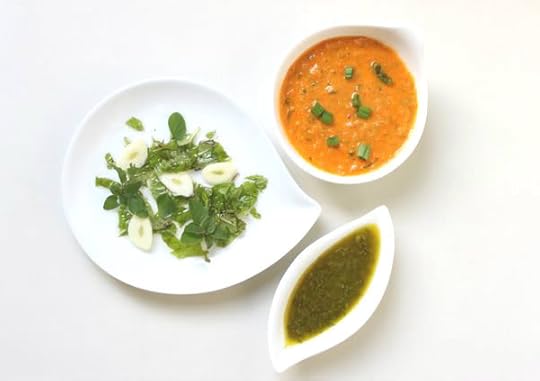 A personal arsenal of go-to Primal meals that can be cooked with little thought, time, or effort is an easy way to keep healthy eating on track. Dinner can be as basic as seasoning a steak with salt and pepper and sautéing veggies in butter. The next day that same leftover steak can show up in a bowl of greens with a little olive oil and lemon and voila! It’s a salad.
A personal arsenal of go-to Primal meals that can be cooked with little thought, time, or effort is an easy way to keep healthy eating on track. Dinner can be as basic as seasoning a steak with salt and pepper and sautéing veggies in butter. The next day that same leftover steak can show up in a bowl of greens with a little olive oil and lemon and voila! It’s a salad.
But here’s the catch – basic is a slippery slope that leads straight to boredom. Luckily, the solution is simple: Give your basic go-to meals a Primal makeover.
As you’ve been hearing lately, my newest cookbook, Primal Blueprint Healthy Sauces, Dressings & Toppings, is a guide to transforming even the simplest meal into something sensational. Your go-to meals will never be boring again with the help of over 120 recipes that make it easy to add extra flavor and nutrients with a sauce, dressing, seasoning, or topping.
But don’t wait for the book to arrive at your door – start transforming those meals now. The following recipes – Spicy Red Pepper Coconut Sauce, Pesto Vinaigrette and Oregano Mint Marinade – are bonus recipes not included in the cookbook. They prove that with a little guidance and inspiration you can make whatever you’re cooking tonight both taste better and be better for you.
Spicy Red Pepper Coconut Sauce
Spicy Red Pepper Coconut Sauce adds nutrients by blending healthy fat (coconut milk and butter) with a brightly colored, antioxidant-rich vegetable (red bell pepper). The bold flavor is an added bonus and will spice up any type of meat or seafood.
This sauce is so good you shouldn’t hesitate to pour it over an expensive grass-fed, organic steak. If that’s not in your budget, then go ahead and buy a less than ideal cut, trim the fat to get rid of unwanted omega-6s, and then add healthy fat back in with this sauce.
Servings: One cup
Time in the Kitchen: 10 minutes
Ingredients:

2 garlic cloves
1 jalapeno, seeded and chopped (or half a jalapeno, for a less spicy sauce)
4 scallions, chopped
1 tablespoon butter, melted (15 ml)
1/4 teaspoon salt (1 ml)
1 roasted red pepper
1/4 cup coconut milk (60 ml)
2 teaspoons lemon juice (10 ml)
Instructions:
Blend the garlic, jalapeno, scallions, butter, salt, and red pepper in a blender until well combined. Pour in the coconut milk and lemon juice and blend until smooth.
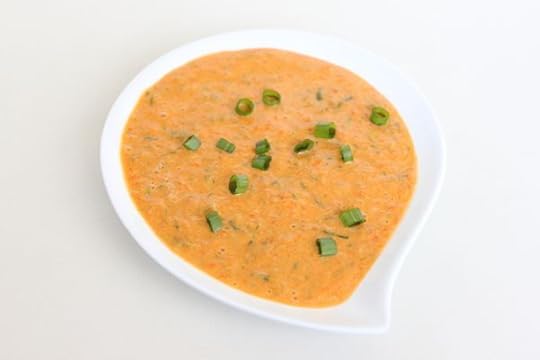
Serve warm or at room temperature.
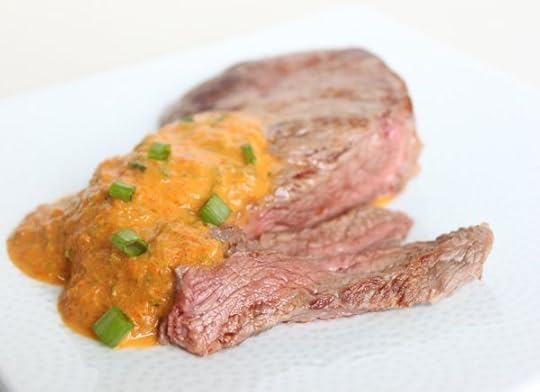
Pesto Vinaigrette
There’s nothing wrong with basic vinaigrettes made from balsamic vinegar and olive oil, or olive oil and lemon. But let’s be honest. When was the last time a simple dressing like that really rocked your world?
And let’s back up a minute…there could actually be something wrong with that vinaigrette if the olive oil has been diluted or replaced entirely with soybean or canola oil. It’s almost impossible to find bottled salad dressings that aren’t made with unhealthy oils and other unwanted ingredients.
A Big Ass Salad is one of the healthiest meals around but if you pour a store-bought dressing on top of your greens, the health benefits might go right out the window. Keep your salads flavorful, interesting, and healthy by using a homemade dressing.
Fresh basil, garlic, olive oil and a drizzle of nut oil mimic the flavors of pesto in this innovative vinaigrette that will add healthy fat and memorable flavor to any salad.
Servings: One cup
Time in the Kitchen: 10 minutes
Ingredients:
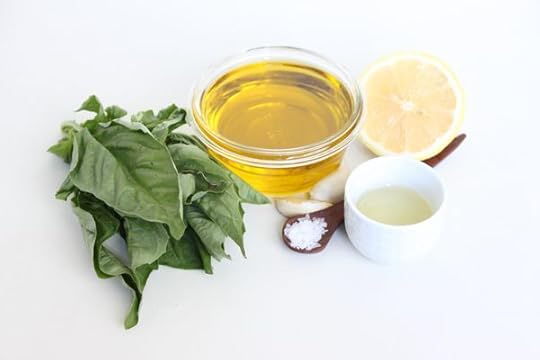
2 cups loosely packed, roughly chopped fresh basil leaves (500 ml)
2 garlic cloves
1/4 teaspoon salt (1 ml)
3 tablespoons lemon juice (45 ml)
2 tablespoons macadamia or walnut oil (30 ml)
3/4 cup olive oil (175 ml)
Optional add-in: 1/3 cup grated Parmigiano-Reggiano cheese (75 ml)
Instructions:
Combine basil, garlic, salt, lemon juice, and nut oil in a food processor until finely chopped.
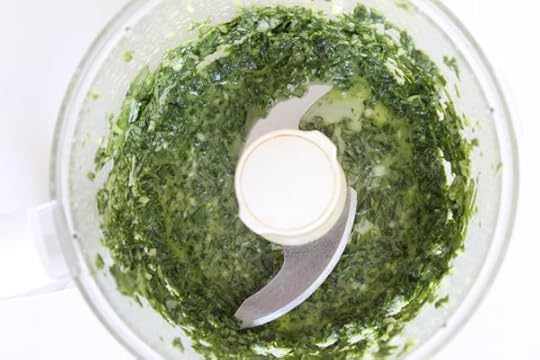
Scrape down the sides, then with the blade running slowly drizzle in the olive oil. After all the oil is added, process for another twenty seconds to finish.
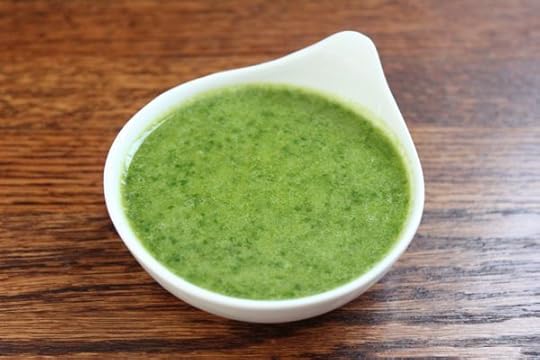
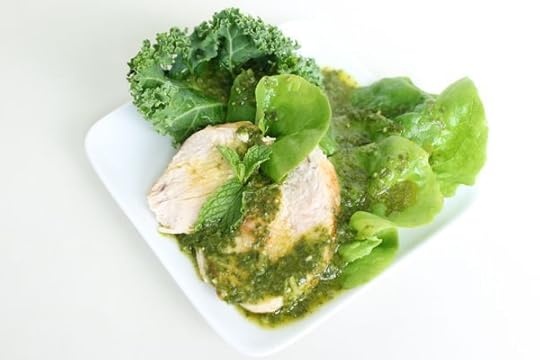
Oregano Mint Marinade
What you’ll notice first when you whip up this marinade is how great it smells. Fresh oregano and mint, raw garlic, and drizzle of coconut oil will fill your kitchen with eye-opening aromatics.
There’s also lot going on behind the scenes in this marinade that your body will thank you for later. Marinades made with fresh herbs like oregano and mint (also rosemary, thyme, and parsley) can lower heterocyclic amines (HCAs) – known carcinogens – by up to 87%. Using coconut oil, which doesn’t easily oxidize, adds an extra layer of defense against high-heat cooking.
Steak, chicken, pork, lamb…it doesn’t matter what you’re cooking. Rub it down with this marinade first and let it rest at room temperature for just 30 minutes. The vibrant flavor of the oregano and mint will come through loud and clear.
Servings: Enough marinade for one pound of meat
Time in the Kitchen: 10 minutes, plus 30 minutes to marinate
Ingredients:
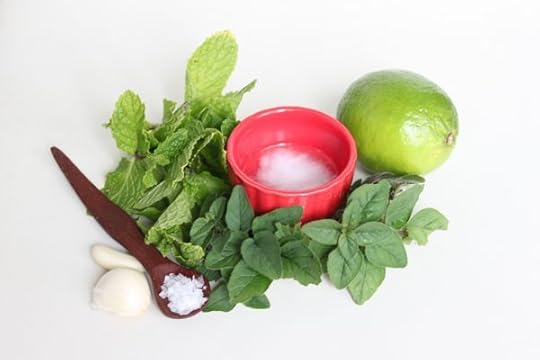
Juice of two limes
3 tablespoons liquid (melted) coconut oil (45 ml)
2 garlic cloves, finely chopped
1/2 cup loosely packed fresh oregano leaves, roughly chopped (120 ml)
1/4 cup loosely packed fresh mint leaves, roughly chopped (60 ml)
1/4 teaspoon salt (1 ml)
Instructions:
Mix all ingredients together (or instead of chopping by hand, blend the ingredients into a paste in the blender). Pour or rub the marinade into the meat. Let the meat marinate at room temperature for thirty minutes before cooking.
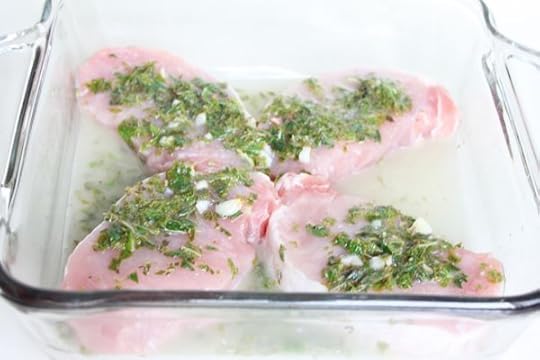
Grilled your meat to perfection and enjoy.
Healthy Sauces, Dressings & Toppings is Now Available!
Primal Blueprint Healthy Sauces, Dressings & Toppings is now available!
This new cookbook is all about turning ho-hum meals into Primal masterpieces with delicious and nutritious sauces, dressings, marinades, condiments, and other toppings. It includes over 120 easy-to-prepare recipes inspired by traditional and contemporary cuisine from around the world. From the staples (ketchup, mustard, hot sauce, mayonnaise) to the innovative (Blueberry Chutney, Coconut Cilantro Pesto, Avocado Lime Dressing), every recipe will enhance the nutritional value of your meal, using only Primal-approved ingredients. That means no gluten, grains, legumes, added sugar, or unhealthy oils. The recipes we developed for this cookbook have already changed the way I prepare my Primal meals. I can’t wait for it to do the same for you.
If you’re a long-time Mark’s Daily Apple reader, you know that I always do something special for devoted readers when I release a new book. To mark this occasion I’ve put together a very special bonus offer with a total value of over 1 million dollars to people that buy one or more copies (it will make the perfect holiday gift!) of the book by December 12. You can read all the details here.
Get Your Copy of Primal Blueprint Healthy Sauces, Dressings & Toppings and Claim Your Bonuses Today!

December 7, 2012
My Health Is Better Than It Has Ever Been
It’s Friday, everyone! And that means another Primal Blueprint Real Life Story from a Mark’s Daily Apple reader. If you have your own success story and would like to share it with me and the Mark’s Daily Apple community please contact me here. I’ll continue to publish these each Friday as long as they keep coming in. Thank you for reading!
 Hello there, Mark.
Hello there, Mark.
Let the storytelling begin…
At the age of 10, I decided to become a vegetarian. Despite my parent’s disapproval, I dove right in and after seven years went whole-hog vegan. Six years later, at the age of 23, I was diagnosed with an immune deficiency, had stopped menstruating, struggled with bloating and constipation, low energy, no libido, and anxiety. At 5’7″ and 135 pounds, I was by no means overweight, but I carried all of it in my belly and had very little muscular definition. The doctors I had seen (and there were many), told me the immune deficiency was incurable and they didn’t know the reason for my amenorrhea. I work as a stage actor, so the chronic infections and lack of vitality were seriously effecting my work and art. I soon gave up on Western Medicine, and started reading everything I could about “alternative healing”. I started seeing an acupuncturist and Chinese herbalist, and the first time I met with both of them the first thing they commented on was my diet. “Maybe you should eat meat” were the last words I wanted to hear, and I remember bursting into tears as soon as I heard them.
I spent the next few months reconsidering why I had chosen to be a vegan: primarily inhumane treatment of animals, and factory farming’s effect on the environment. Then it came to me – I don’t have to eat animals who were being treated inhumanely! I don’t have to eat animals from factory farms! And I decided it was more important to do what I had to do to be as healthy as possible in order to give myself fully to the world and my art.
I found local farms and farmers markets, and read a LOT about nutrition. Eventually I was led to The Primal Blueprint and it was exactly what I had been looking for. I started the next day.
It took two years of paleo to curb my regular upper-respiratory infections, but the past four years, I’ve only gotten sick twice! I use some herbal remedies, but no western medicine (sans one round of antibiotics). Two years ago, after seeing a kinesiologist who suggested I drop all carbohydrates and sugars to accelerate the healing process, I went zero carb. I dropped underweight, to 113 pounds, because I still wasn’t menstruating and didn’t have hormonal balance. My energy had gone through the roof, though, and my anxiety was no longer overwhelming!
Then BAM, after six months of zero carb, my hormones balanced over night – my period started, I gained 25 pounds, grew a bum, went up two cup sizes, my hair curled (seriously!), and my libido came back full-force. Suddenly I was a woman. It was terrifying!
I’ve upped the carbs since (tho not too much – under 50 grams is where I feel best for now), and my health is better than it’s ever been…
And that’s where I’m at today – an hourglass, fertile, healthy, medicine-free WOMAN. Thank you, Mark. I feel like you held my hand through my second puberty!
And here are some pictures…
This is “before” – 23, vegan, 5’7″, 135 pounds, belly bloat, sick a lot…

This is “during” (I’m on the left side of the photo) – 27, underweight at 113 pounds, very vital, but still not menstruating…
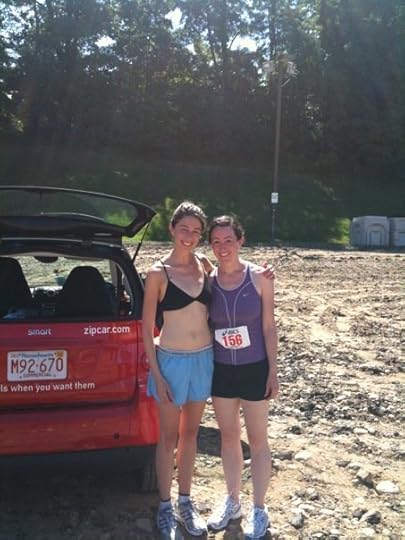
And this is “now”- 137lb, fertile, healthy, curly! (and still working on getting the boyfriend paleo:))

Thank you so much, Mark.
xx
Adina
Get Your Copy of Primal Blueprint Healthy Sauces, Dressings & Toppings and Claim Your Bonuses Today!

December 6, 2012
The Physical Benefits of Positive Emotions
 Last week’s post on negative emotions got people talking about the intersection of mental and physical wellbeing. It also filled my inbox (a very good thing, in my opinion). True, it’s not usual subject matter for MDA. Living Primally, however, is about taking a full and nuanced view on enhancing our health. That’s what we’re all after, isn’t it? So, if we recognize how negative emotions – when they’re allowed to linger beyond their natural, short-term function – can undermine our physiological wellbeing, why not take a look at the flip-side? Is positive thinking mere psychobabble fluff as some would argue? Does it attract love, opportunity, and other good energies the universe has to offer? I’ll leave these angles for others to explore (although feel free to argue your own perspective on the board). For my part, I’m all about the brass tacks basics. I’m sure you can guess: the physiological impact of positive feelings and their potential evolutionary roots. Call me a simple guy.
Last week’s post on negative emotions got people talking about the intersection of mental and physical wellbeing. It also filled my inbox (a very good thing, in my opinion). True, it’s not usual subject matter for MDA. Living Primally, however, is about taking a full and nuanced view on enhancing our health. That’s what we’re all after, isn’t it? So, if we recognize how negative emotions – when they’re allowed to linger beyond their natural, short-term function – can undermine our physiological wellbeing, why not take a look at the flip-side? Is positive thinking mere psychobabble fluff as some would argue? Does it attract love, opportunity, and other good energies the universe has to offer? I’ll leave these angles for others to explore (although feel free to argue your own perspective on the board). For my part, I’m all about the brass tacks basics. I’m sure you can guess: the physiological impact of positive feelings and their potential evolutionary roots. Call me a simple guy.
Barbara Fredrickson, Professor of Psychology at the University of North Carolina, Chapel Hill, has spent years researching the role of positive emotions in human health and cognition – and assembling a theoretical picture of their evolutionary value. According to her “Broaden and Build Theory,” positive emotions were selected for over the long-term because they allowed for a “cognitive flexibility” that allowed for the development of a broader “repertoire” of behavioral choices. In other words, positive feelings encouraged our ancestors to consider situations differently and make new and novel choices that ended up enhancing their survival. More open thinking led them to smarter decisions or more effective solutions to problems they and their kin faced.
Mull for a minute your thinking when angry versus happy, dejected versus hopeful. When do you feel more productive and creative? While negative emotions often push us toward knee jerk or at least simplified reactions (which had their immediate adaptive value at some point), positive emotions “broaden” or open our field of vision. They invite musing, play, and invention. Fredrickson and her team have even studied the literal connections among positive emotion, expansive thought, and physical attention. Good feelings, they’ve found, enhance our “global” (i.e. big picture) thinking, and even expands our perception of what’s in our peripheral vision. As subtle as these cognitive benefits can seem, they could mean the difference between life and death in the hard scrabble, unpredictable world of our forebears.
From a physiological standpoint, research has shown that positive emotions as varied as love, compassion, and gratitude encourage “harmonious” heart rhythms. In other words, emotional equanimity fosters synchronized, balanced, and efficient physiological patterns in the cardiovascular and nervous systems. Other research suggests that even more abstract positive emotions like hope and curiosity offer protective benefits from diseases like high blood pressure and diabetes. Are correlations like this hard to confirm in the messy, nuanced picture of individual lives? Sure. Nonetheless, there’s clear logic behind the premise. The more time we spend in emotional states that put our body in physiological balance, the better our health will be. Fredrickson highlights the physical power of positive emotions in a theory she calls “undoing.” Aside from the cognitive advantages, the primary physiological benefit of positive emotions is the “undoing” of negative stress induced responses. Good feelings calm our cardiovascular reactivity and sympathetic nervous systems. Positivity, in other words, returns us to physical homeostasis. Hmmm…positivity as a default setting? There’s an intriguing thought.
All this begs the question, what emotions fuel our lives? How much positivity do we experience in a day – and how much negativity do we need to recover from? Fredrickson’s research suggests we need at least three positive emotions to one negative in order to “flourish” within our individual lives and relationships. How do we stack up?
I’d suggest the real point isn’t bean counting our way through emotional interactions each day. Nor is it about forcing a shiny, happy attitude on your life. Living deeply and authentically involves experiencing the full spectrum of human emotion, about discovering the depths of human feeling. There’s a unique magnitude to be found in the more solemn dimensions of our lives. Ultimately, however, it isn’t about the sum of happy, carefree circumstances but the rich as well as positive feelings we cultivate in response to life. Do we find meaning in the overall endeavor? Do we allow ourselves to see beauty in a day? Do we choose experiences and entertainment that move us emotionally? Do we ultimately drink up the positivity of our lives – the possible love, gratitude, inspiration, humor, and contentment?
Allowing ourselves to recognize and relish the positive in life doesn’t diminish the suffering some people endure or justify the injustices of the world. Nor does it undo the heavier burdens we may carry. Nonetheless, when we recognize the power of positive emotion on our wellbeing – indeed, the critical role of positivity in our basic health, it’s a downright shame to deny ourselves the full portion of its benefits.
Thanks for reading today, everybody. Let me know your thoughts on positivity and the role it has in your life.
Get Your Copy of Primal Blueprint Healthy Sauces, Dressings & Toppings and Claim Your Bonuses Today!

December 5, 2012
A Brand New Primal Blueprint Cookbook PLUS a Limited-Time $1 Million Bonus Giveaway
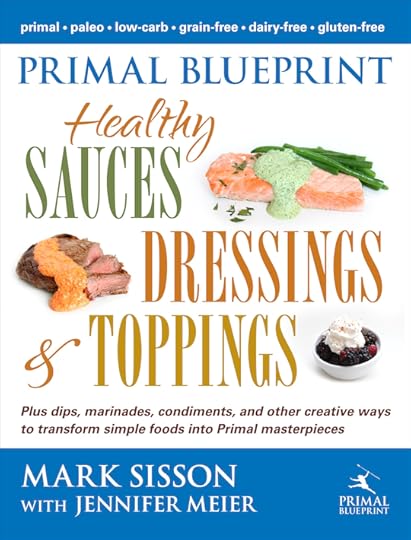 Primal Blueprint Healthy Sauces, Dressings & Toppings is now available, and I’m giving you some incredible bonus packages when you buy one or more copies over the next week. But more on that in a moment. First, the real star of the show.
Primal Blueprint Healthy Sauces, Dressings & Toppings is now available, and I’m giving you some incredible bonus packages when you buy one or more copies over the next week. But more on that in a moment. First, the real star of the show.
After the extraordinary success of The Primal Blueprint Cookbook and Primal Blueprint Quick & Easy Meals, co-author and chef Jennifer Meier and I sat down to dream up the concept for the next cookbook. It didn’t take long because I had a personal itch to scratch.
We all have our go-to meals – meals that we eat day-in, day-out. Mine? An omelet for breakfast, a Big Ass Salad (BAS) for lunch, and grilled lamb chops and veggies for dinner. I almost never get tired of these meals. The key word in that sentence is almost. Variety is the spice of life, as they say, so the challenge was to find numerous ways to transform basic Primal meals into dishes that are not only better tasting, but better for you. And that’s exactly what we’ve done. A grilled steak is a grilled steak is a grilled steak. But a grilled steak smothered in our Coconut Cilantro Pesto, or topped with Bacon Chive Butter is out of this world!
Primal Blueprint Healthy Sauces, Dressings & Toppings is all about turning ho-hum meals into Primal masterpieces with delicious and nutritious sauces, dressings, marinades, condiments, spice blends, gravies, and other toppings. It includes over 120 easy-to-prepare recipes inspired by traditional and contemporary cuisine from around the world. From the staples (ketchup, mustard, barbecue sauce, hot sauce, mayonnaise) to the innovative (Blueberry Chutney, Arugula Watercress Pesto, Avocado Lime Dressing), every recipe will enhance the nutritional value of your meal, using only Primal-approved ingredients. That means no gluten, grains, legumes, added sugar, or unhealthy oils.
Healthy Sauces, Dressings & Toppings Book Trailer
The recipes we developed for this cookbook have already changed the way I prepare my Primal meals. I can’t wait for them to do the same for you. So pick up a copy today. It’s also a great gift idea to help those friends and loved ones who might be a little resistant to inch their way toward a Primal eating strategy. As you contemplate your gift list, take a look at the bonuses you get for ordering one or more…
$1 Million Bonus Giveaway
If you’re a long-time Mark’s Daily Apple reader, you know that I always do something special for devoted readers when I release a new book. The only way this time is different is that it’s bigger than ever…
Here’s how it works:
Order one or more copies of Primal Blueprint Healthy Sauces, Dressings & Toppings from any retail location (online or brick and mortar) in any format (physical or digital) between now and Dec. 12, and you’ll receive a plethora of bonus items as a token of my appreciation. All you have to do is pick your bonus package below, place your order, send me a copy of your receipt through a special online form, and you’ll receive all your bonuses in no time. See the instructions and fine print below for further details.
This new cookbook makes the perfect gift, and comes just in time for the holidays. Get all your holiday shopping done in a matter of minutes and take advantage of this limited-time offer by ordering multiple copies today.
My hope is that with your help, this cookbook will climb to the New York Times bestseller list, and we’ll continue to get the Primal Blueprint message the exposure it needs to affect real change. Many thanks in advance for participating. I hope you enjoy the book and all your free bonuses. Grok on!
Side note: Along with this new cookbook, I’m also excited to announce a brand new Primal Blueprint Poster, Primal Blueprint “Gluten for Punishment” Hoodie, and Primal Blueprint “I’m An Offal Chef!” Apron. You can get all of these for free when you buy multiple copies of the cookbook (see details below), or you can purchase them directly by following the links above.
Now, the special bonuses…
The Primal Chef Bonus Offer
Bonus Summary:
12-Month Subscription to Paleo Lifestyle E-Magazine ($35.88)
Delicious Paleo Roasts E-book from paleocookbook.com ($12)
The Modern No-Nonsense Guide to Paleo from PaleoNonPaleo.com ($15)
$10 Gift Certificate to PrimalBlueprint.com ($10)
The Primal Blueprint Audiobook (MP3) ($26.95)
Total bonus value: $100 (for an $18 book)
Instructions:
Buy 1 or 2 copies from Amazon, Barnes and Noble or any other book retailer.
Fill out this form to get your bonuses.
Just buy two more copies and you’ll qualify for…
The Friends and Family Bonus Offer
Bonus Summary:
The Primal Blueprint “I’m an Offal Chef!” Apron ($20)
The Primal Blueprint Poster ($14.95)
The Primal Blueprint Wristband ($2.50)
$20 Gift Certificate to PrimalBlueprint.com ($20)
Paleo Lamb Recipes E-book from paleocookbook.com ($12)
12-Month Subscription to Paleo Lifestyle E-Magazine ($35.88)
Delicious Paleo Roasts E-book from paleocookbook.com ($12)
The Modern No-Nonsense Guide to Paleo from PaleoNonPaleo.com ($15)
The Primal Blueprint Audiobook (MP3) ($26.95)
Total bonus value: $159 (for approx. $54 of books) – Limited to First 2,000 Orders
Instructions:
Buy 3 to 7 copies from Amazon, Barnes and Noble or any other book retailer.
Fill out this form to get your bonuses.
Just buy five more copies and you’ll qualify for…
The Get All Your Holiday Shopping Done In 5 Minutes Bonus Offer
Bonus Summary:
The Primal Blueprint 90-Day Journal ($22.95)
The Primal Blueprint , autographed/hardcover copy ($26.95)
Vital Omegas – Fish Oils ($24.95)
$10 Gift Certificate to Tendergrass Farms ($10)
The Primal Blueprint “I’m an Offal Chef!” Apron ($20)
The Primal Blueprint Poster ($14.95)
The Primal Blueprint Wristband ($2.50)
$30 Gift Certificate to PrimalBlueprint.com ($30)
Paleo Lamb Recipes E-book from paleocookbook.com ($12)
12-Month Subscription to Paleo Lifestyle E-Magazine ($35.88)
Delicious Paleo Roasts E-book from paleocookbook.com ($12)
The Modern No-Nonsense Guide to Paleo from PaleoNonPaleo.com ($15)
The Primal Blueprint Audiobook (MP3) ($26.95)
Total bonus value: $254 (for approx. $144 of books) – Limited to First 1,000 Orders
Instructions:
Buy 8 to 29 copies from Amazon, Barnes and Noble or any other book retailer.
Fill out this form to get your bonuses.
Or grab more copies for your entire social network, your gym, or all of your clients and you’ll qualify for…
The Gym Owner/Trainer Bonus Offer
Bonus Summary:
Damage Control Master Formula ($129)
Primal Fuel ($79)
Vital Omegas – Fish Oils ($24.95)
Primal Flora ($26.95)
Vitamin D ($9)
Primal Calm ($49)
Primal Blueprint “Gluten for Punishment” Hoodie ($40)
1 x Grass-Fed Paleokit from Steve’s Original ($4.95)
2 x Two-Pack of Nick’s Sticks from Nick’s Sticks ($12)
The Primal Blueprint 90-Day Journal ($22.95)
The Primal Blueprint , autographed/hardcover copy ($26.95)
$10 Gift Certificate to Tendergrass Farms ($10)
The Primal Blueprint “I’m an Offal Chef!” Apron ($20)
The Primal Blueprint Poster ($14.95)
The Primal Blueprint Wristband ($2.50)
$30 Gift Certificate to PrimalBlueprint.com ($30)
Paleo Lamb Recipes E-book from paleocookbook.com ($12)
12-Month Subscription to Paleo Lifestyle E-Magazine ($35.88)
Delicious Paleo Roasts E-book from paleocookbook.com ($12)
The Modern No-Nonsense Guide to Paleo from PaleoNonPaleo.com ($15)
The Primal Blueprint Audiobook (MP3) ($26.95)
Total bonus value: $604 (for approx. $540 of books) – Limited to First 50 Orders
Instructions:
Buy 30 to 99 copies from Amazon, Barnes and Noble or any other book retailer.
Fill out this form to get your bonuses.
Or grab even more copies for your company health and wellness program and you’ll qualify for…
The Corporate Bonus Offer
Bonus Summary:
30-Minute Phone Call with Mark Sisson
The Entire Primal Blueprint Library ($132.87)
The Primal Connection ($24.95)
$50 Gift Certificate to US Wellness ($50)
$25 Gift Certificate to Ethereal Confections ($25)
Bottle of Gold Label Virgin Coconut Oil from Tropical Traditions ($40)
Damage Control Master Formula ($129)
Primal Fuel ($79)
Vital Omegas – Fish Oils ($24.95)
Primal Flora ($26.95)
Vitamin D ($9)
Primal Calm ($49)
Primal Blueprint “Gluten for Punishment” Hoodie ($40)
1 x Grass-Fed Paleokit from Steve’s Original ($4.95)
2 x Two-Pack of Nick’s Sticks from Nick’s Sticks ($12)
$10 Gift Certificate to Tendergrass Farms ($10)
The Primal Blueprint “I’m an Offal Chef!” Apron ($20)
The Primal Blueprint Poster ($14.95)
The Primal Blueprint Wristband ($2.50)
$30 Gift Certificate to PrimalBlueprint.com ($30)
Paleo Lamb Recipes E-book from paleocookbook.com ($12)
12-Month Subscription to Paleo Lifestyle E-Magazine ($35.88)
Delicious Paleo Roasts E-book from paleocookbook.com ($12)
The Modern No-Nonsense Guide to Paleo from PaleoNonPaleo.com ($15)
The Primal Blueprint Audiobook (MP3) ($26.95)
Total bonus value: Over $1000 (for approx. $1800 of books) – Limited to First 10 Orders
Instructions:
Buy 100 or more copies from Amazon, Barnes and Noble or any other book retailer.
Fill out this form to get your bonuses.
Note: To order 100 books on Amazon simply add any quantity of the book to your shopping cart. On the next page – the checkout page – you’ll be able to increase the quantity to 100 or more.
The Special Event Bonus Offer
Buy 1,000 books directly from me and you’ll get everything in the 100 book offer above plus I’ll fly out to your house, gym, or company for a one-on-one or group consultation. Call 888-774-6259 for the details and to place your order.
I’ll match Amazon or B&N’s lowest price of the day the day you place your order. I’ll cover S&H of all the books. Limited to 3 orders. Only U.S. locations are eligible.
Fine Print:
This special bonus offer ends at 11:59 pm, Dec. 12, 2012 (PST).
These bonus offers are strictly first come, first served. “Limited to 10 orders” means the eleventh person doesn’t get it. The receipt submission forms will automatically stop accepting entries once limits have been reached.
All receipts must be received by 11:59 pm, Dec. 15, 2012 (PST). The forms will stop working on or before Dec. 16, so be sure to fill out the form and submit your pre-Dec. 13 receipt(s) by then.
Pre-orders will be honored for all bonus offers.
Both orders placed online and in brick and mortar retail locations will be honored.
All book formats are eligible, including physical books and and digital versions (e.g. Kindle).
Your email address and shipping address will be shared with sponsors in order to distribute bonuses. Sponsors may contact you to make delivery arrangements and with special offers.
You will receive all PrimalBlueprint.com digital bonuses within 24 hours, all sponsor digital bonuses within two weeks, and all physical goods within three weeks.
Shipped bonuses (i.e. all physical bonuses in the 3 or more bonus offer) are only available to those with shipping addresses in the United States. In other words, all bonuses in the 1 book offer and all digital bonuses (i.e. all things that can be sent by email and don’t require shipping) in the 3 book offer and beyond are available to all international participants.
PrimalBlueprint.com gift certificates and free audiobook coupon codes expire on Jan. 31, 2013.
The book is not yet available on PrimalBlueprint.com.
Hat tip to Tim Ferriss for the inspiration for this special promotion.
Get Your Copy of Primal Blueprint Healthy Sauces, Dressings & Toppings Today!

December 4, 2012
Should We Ice Injuries?
 I’ve said this before, but inflammation is a necessary response to injury. It’s the inflammatory response that increases blood and lymphatic flow to and from the injured tissues, bringing healing nutrients and inflammatory mediators and removing damaged refuse. It’s the inflammatory response that makes injuries hurt, which prevents us from using and re-injuring the injured area. And yeah, the inflammatory response can get out of hand and do more damage than the initial insult, but it’s ultimately how our bodies heal damaged tissues and recover from injuries. If we didn’t have an inflammatory response, we’d never get anywhere. This was the crux of a very interesting blog post by Kelly Starrett in which he questioned the typical use of ice after injury. In short, Kelly says that putting ice on a healing tissue is counterproductive because it halts or at least disrupts inflammation, which is really how we heal.
I’ve said this before, but inflammation is a necessary response to injury. It’s the inflammatory response that increases blood and lymphatic flow to and from the injured tissues, bringing healing nutrients and inflammatory mediators and removing damaged refuse. It’s the inflammatory response that makes injuries hurt, which prevents us from using and re-injuring the injured area. And yeah, the inflammatory response can get out of hand and do more damage than the initial insult, but it’s ultimately how our bodies heal damaged tissues and recover from injuries. If we didn’t have an inflammatory response, we’d never get anywhere. This was the crux of a very interesting blog post by Kelly Starrett in which he questioned the typical use of ice after injury. In short, Kelly says that putting ice on a healing tissue is counterproductive because it halts or at least disrupts inflammation, which is really how we heal.
Do we want to use ice in order to reduce the inflammation incurred after a soft tissue injury?
Let’s establish what we mean by “inflammation” after an injury. We’re really talking about the inflammatory process, which includes pro-inflammatory and anti-inflammatory processes. It begins with the release of inflammatory mediators that cause vasodilation, or widening of the bood vessels, at the injury site. This allows more blood to arrive, and with it leukocytes and macrophages (types of white blood cells) to clean up the site and moderate the inflammation. More fluid at the site also means swelling, or edema, which, along with the increased sensitivity to pain, restricts movement and allows the inflammatory process to progress. But once that fluid is filled with waste products from cellular cleanup, it needs to be drained. That’s where the lymphatic system comes in. The lesser-known circulatory system, the lymphatic system removes all the waste products and excess fluid buildup caused by the inflammatory process. When the waste fluid is drained, healing can commence.
Since the lymphatic system doesn’t have a big multi-valved muscle in the center of the chest controlling the flow of fluid through its vessels, we need to get the lymph draining smoothly through other means, like elevating, compressing, or moving the tissue. What about icing? Kelly and his guest in that video above say that icing an injury promotes fluid build-up and restricts lymphatic flow. To reduce swelling, they like compression over icing, because the former doesn’t affect the lymphatic flow in a negative way.
How do these claims play out?
Icing a specific areas definitely disrupts the overall inflammatory process, lowering both inflammatory and anti-inflammatory cytokines. Icing muscles after a sprint workout, for instance, seemed to reduce levels of IGF-1 (an anabolic marker that usually increases after injury/exercise and improves healing/recovery), IL-1ra (an anti-inflammatory cytokine), and IL-1β (an inflammatory cytokine) while increasing levels of IGFBP-1 (a catabolic marker that breaks down tissue). Those are just markers, though, and an ankle sprain is not a sprint workout. But still – the responses to exercise and injury are based on the same inflammatory and anti-inflammatory mediators. If one’s affected, the other likely is, too.
As for lymph flow, it’s been shown (albeit in a reference I can’t fully access) that prolonged application of ice to tissue enhances the lymphatic vessels’ permeability, causing “backflow” of waste fluid back into the injured area, worsening edema, and potentially extending healing time.
So, is that that? Icing is bad?
Not so fast. With some injuries, it’s been shown to help. Clinicians are actually using cold therapy to induce hypothermia and reduce brain injury and mortality while improving the outcome in patients who’ve just had a stroke. Or after something like pelvic surgery (which is a traumatic controlled injury of sorts), cold therapy can improve erection function and reduce incontinence. Following “primary injury” (the stroke) the application of cold is preventing “secondary injury” (brain damage) to the surrounding tissues originally uninvolved in the initial injury. Though this secondary injury phenomenon also exists with soft tissue injuries, and ice therapy seems to work in its prevention, the window of opportunity for intervention is pretty small – perhaps just the first thirty minutes after the initial trauma.
Icing your ankle right after a really bad sprain to prevent secondary injury seems to make sense, but does it help with swelling and overall healing?
A 2004 literature review on the ability of cryotherapy to affect soft tissue injury healing looked at 22 eligible randomized controlled studies to determine if ice was actually helping, and the results were mixed at best:
Ice alone was better for pain after knee surgery when compared to no ice, but swelling and range of motion were not affected.
Ice was no more effective than rehab in reducing swelling, pain, and range of motion.
Ice and compression were better than ice alone at pain reduction.
Of eight studies that compared the two, there was little difference between ice and compression and compression alone.
They conclude that “based on the available evidence, cryotherapy seems to be effective in decreasing pain,” but evidence is scant for any further conclusions. Another review using many of the same studies had similar findings, noting that the vast majority of the available studies purporting to examine the effect of cryotherapy on soft tissue injury employ surgery patients with open injuries. The authors stress the need for more research using patients with closed soft tissue injuries – sprains, strains – rather than surgery patients.
And that’s the big problem: there simply isn’t a lot of real, hard research on how icing affects the types of commonplace injuries people actually get. And why would there be? “Everyone knows” that you ice a sprained ankle. That’s just what you do. What’s there to study? Thus, most of the research on “soft tissue injury” either preemptively accepts icing as efficacious or uses surgery patients with open soft tissue injuries when what we should really be looking at are people with ligament, tendon, and muscle strains and sprains.
One thing to consider is that ice is rarely used in isolation. RICE, the acronym that everyone seems to follow after an injury, stands for “rest, ice, compression, elevation.” It’s the standard advice you’ll hear from most PTs and docs: rest the affected area, apply ice, compress it, and elevate the tissue. Thus, many studies that seem to show efficacy for cryotherapy also use compression, making it difficult to disentangle the two. Is it the ice or the compression, or the combo of both doing the work?
Indeed, some evidence suggests that compression is key. I was unable to find many studies that compared compression alone, icing alone, and doing nothing, but there are several studies showing major benefit for compression and icing over icing alone. Most recently, subjects recovering from recent ACL surgery received either icing or compression+icing. The compression+icing group had better pain relief and a marked reduction in pain medication usage when compared to the icing group. However, an earlier meta-analysis found that while cryotherapy after ACL surgery seemed to help with pain, it did not improve range of motion or drainage. In other words, it was good for pain but did nothing to actually speed the healing process or get patients back to action. And in the one study I did find that isolated compression and icing, compression bested both types of icing – continuous cryotherapy and intermittent ice pack application – in the reduction of post-foot-or-ankle-injury swelling.
The problem with RICE, as I see it, isn’t that icing is in there, it’s that people focus way too much on the icing and do it way to the exclusion of compression, while totally misinterpreting the rest and elevation recommendations. You’re not supposed to stay completely immobile and sedentary with your iced leg up on the couch for weeks while watching bad TV. After the initial downtime, you need to move! As soon as you’re able to move without pain, you should be mobilizing the affected tissue. Don’t go hiking on a broken leg or swollen ankle or anything, but don’t assume inactivity is best. Keep your movements pain free and unloaded to begin with. Rotate that sprained ankle. Flex and extend that hurt elbow. And so on. If you’re going to ice, keep it short and sweet and immediately after the initial injury. Err on the side of moderation. Most studies indicate that the coldest temperatures are less effective at reducing swelling and may even increase it, while the “cooler” temperatures were better at reducing swelling.
So, to answer the initial question: it depends.
Clearly, people aren’t losing limbs and whittling away their connective tissue despite the prevalence of icing after injury, so I don’t think the situation is that dire. It goes both ways, of course; people aren’t going to turn into shattered husks of their former athletic selves just because they neglected to ice an injury or two.
Ultimately, I don’t think icing is as unequivocally detrimental to the healing process. It can certainly reduce pain and, if that’s the only way for you to get the tissues moving, that’s a good thing (as long as you don’t move too much too fast and end up re-injuring the weakened tissue). And it can likely prevent secondary tissue damage, particularly if you apply it shortly after an acute injury. But the extended, constant, day-in day-out cryotherapy that some of us feel is absolutely necessary anytime a tissue feels less than perfect? No. It seems clear to me that compression and mobilization of the injured area are likely more important and effective than ice.
I don’t want anyone to subject themselves to a laboratory limb contusion or anything, but I’d be real curious as to how you Primal folks handle your injuries. Do you ice them? Do you let the inflammatory cards fall as they may, confident that the composition of your tissue fatty acids will provide a suitable inflammatory response?
Let us know how it’s been working out for you in the comment section! If there are any physical therapists or coaches out there, I’d be particularly interested in your take on this.
Grab The Primal Blueprint Cookbook Today and Receive Free S&H and a Free Primal Blueprint Poster

December 3, 2012
Dear Mark: Can’t Squat, Please Help; Plus, High CRP, No Symptoms, and Glutathione
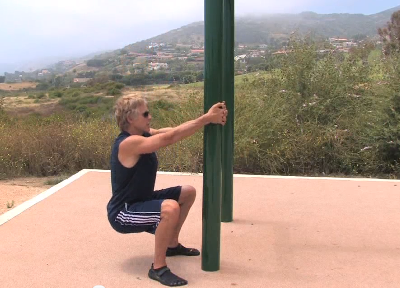 In this week’s edition of “Dear Mark,” I answer two reader emails that end up being more like three questions. First, I try to help out Alex, who’s having trouble reaching full depth in the Grok squat without falling over backwards. This is a common issue, believe it or not, and luckily there are some pretty simple fixes that people can try. In my response, I explain why he might be toppling over and what he can do to fix it. After that, I answer a question about C-reactive protein, the “inflammation” marker. One reader is feeling great and sitting at an ideal body weight, but a recent blood test in which CRP was elevated has worried her. She wants to know what she can do about it, so I explain why it might be elevated, why it might not be an issue, why it might be one, and what she can do to boost glutathione, which her doctor recommended she increase.
In this week’s edition of “Dear Mark,” I answer two reader emails that end up being more like three questions. First, I try to help out Alex, who’s having trouble reaching full depth in the Grok squat without falling over backwards. This is a common issue, believe it or not, and luckily there are some pretty simple fixes that people can try. In my response, I explain why he might be toppling over and what he can do to fix it. After that, I answer a question about C-reactive protein, the “inflammation” marker. One reader is feeling great and sitting at an ideal body weight, but a recent blood test in which CRP was elevated has worried her. She wants to know what she can do about it, so I explain why it might be elevated, why it might not be an issue, why it might be one, and what she can do to boost glutathione, which her doctor recommended she increase.
Let’s go:
Hi Mark,
I’m having trouble with the Grok Stretch.
I feel like I’ve read everything I could find about how to do it properly and watched all the videos you have available, but I can’t get down there without falling over.
What I’m wondering is: is my balance issue just one of my muscles and joints needing to be accustomed to the stretch? The reason I’m curious is that you describe it over and over as a “relaxation”, that is, I shouldn’t be contracting my muscles or leaning forward on the balls of my feet. Rather, I should just relax and sit back and be comfortable. My problem is that when I get down into the position where my heels are on the floor and I’ve got my center of mass lined up properly, I can’t not fall over backward. I can hold it for maybe 10 seconds tops, but, when I do that, my muscles are all very tight and it’s clearly not relaxing.
If you have any thoughts, they’d be very much appreciated!
Best,
Alex
I can think of two things that may be impeding your progress: your calves are tight and you’re trying to maintain a vertical torso. Most people who spend any time wearing shoes with heels (even slightly pronounced ones) probably have tight calves. When your heel is elevated, whether it’s because you’ve raised up on your toes or you’re wearing a shoe with heels, your ankle is in a state of plantarflexion, or moving toward an angle greater than 90 degrees. When your ankle is in plantarflexion, your calf is contracted and “shortened.” Calf raises also put your ankle into plantarflexion in order to target and work your calves. If you’re just walking around in some tennis shoes with a half inch or two of heel, your calves are going to languish in mild contraction and, over time, this contraction can be a semi-permanent position for your calves.
When you try to squat with tight calves, you run into problems. You’ll naturally want to shift enough body weight forward to maintain your balance over your feet, but this requires ample amounts of ankle dorsiflexion (angle less than 90 degrees). If your calves are too tight, you won’t be able to dorsiflex your ankle, and your knees won’t be able to travel forward enough to shift a sufficient amount of bodyweight forward to maintain balance. Tight calves force you to keep all the weight on the back half, causing you to fall backward.
Second, you’re probably trying to maintain too vertical a torso. This is understandable, because so many people talk about the need for a neutral spine when squatting, and that gets mixed up with a vertical spine. Squatting is all about balance, and counter balance. If you’re squatting and want to keep an upright torso, you need full ankle dorsiflexion, particularly if you have tight calves. Otherwise, all the weight will stay in the back, and you’ll fall over. If you ever watch Olympic lifters doing a front squat, their backs are only able to stay vertical because they’re able to push their knees far ahead of their toes; this allows them to maintain balance. That takes flexible calves – flexible enough to allow full dorsiflexion at the ankle and a knee forward position. If they tried to keep a vertical torso with tight calves, vertical shins, and knees behind the toes, they would fall over, just like you’re doing. Does that sound familiar? Watch what happens to this guy when he tries to squat – is that you?
Going up onto your toes is a lot easier because it elevates the heel, reduces the need for full ankle dorsiflexion, and makes it easier to maintain and upright torso, which is why most Westerners must default to a toes down, heel up squat. There’s nothing wrong with doing that kind of squat as long as it’s unweighted, but you want to have enough flexibility to sit in a full heels down squat, too.
Reduce the time you spend in passive ankle plantarflexion.
Start wearing minimalist shoes with a zero-drop heel, or go barefoot more often.
When you sit down, try to keep your feet flat on the floor. Too often we point our toes to the ground and elevate our heels.
Mobilize your calves.
You’re gonna have to stretch and mobilize your calves, particularly if you continue to plantarflex your way through life (hey, sometimes you just wanna wear some nice heels). This is the best calf stretch I’ve found (skip to around 3:00 for the actual stretch, if you’re short on time). Here’s an article describing it, with plenty of helpful pictures. Try the stretch for two minutes for each calf, with knee straight and bent, and see how it affects your squat.
I’d also recommend you practice sitting deep into a full squat while holding onto something in front of you for stability, like a pole as in the picture above. By holding on to the pole, you provide an external counterbalance and eliminate the need for an internal counterbalance. This allows you to really accentuate the ankle dorsiflexion; you can almost pull yourself into it and really stretch those calves and get used to being in a proper squat. Make sure you keep those heels down or you’ll lose the stretch.
Also, a Grok squat stretch doesn’t have to be perfect. Your back probably won’t be totally vertical, and that’s fine. You might lean forward. The lower back might even round! Don’t stress over it. Even the pros let their backs round at the bottom of a bodyweight squat. However, let me make this clear: your lower back should not round on weighted squats.
Dear Mark,
I have been primal for over two years and I feel great. My weight is perfect and so is pretty much everything – that is until I got my blood tests done (by a primal doc!). All results came back in glorious primal fashion except my inflammatory numbers! My CRP was 7.4 (optimally it should be below 1.00). My other inflammation/oxidation numbers were also high. The thing is I have no symptoms. My doctor recommended taking whey because it helps the body produce Glutathione, the body’s master anti-oxidant. The thing is, I dislike taking it. It feels processed and not the whole food I am used to. Is there a better way to get Glutathione into my body? I know supplements aren’t supposed to work that well…and any other ideas to bring down the inflammation? Thank you!
Diane
That is an interesting case. Elevated CRP is potentially worrisome, I agree, because it’s a sensitive barometer of any kind of inflammation occurring in the body. You sprain an ankle, CRP goes up. You get an infection, CRP goes up. You run a marathon or do an intense CrossFit WOD, CRP goes up. You get a cold or the flu, CRP goes up. You have an autoimmune disease flare-up, CRP goes up. It could be multiple sclerosis, or chronic stress, or acute stress, or sleep apnea, or almost anything. So, CRP going up can mean something very bad, or it can simply represent a transient, benign increase in inflammation due to exercise or a single bad night’s sleep. It’s nothing to freak out about, but it’s definitely something to investigate.
Did you have a particularly intense workout prior to the test? CRP levels can be significantly elevated 24 hours after physical exertion, so this may be confounding the results. One study – in marathoners – even found that CRP levels went up 2000%. Other inflammatory markers were also affected.
You may have a variant in the “CRP gene” that predisposes you to higher CRP numbers without any additional base inflammation. Folks with the variants effectively have a CRP set point 64% higher than “normal” folks. So, a 7.4 CRP in one of these people might be equal to a 1.0 CRP in a “normal” person, even though they have the same “level” of inflammation. In fact, a recent study showed that although people with genetically high CRP numbers are theoretically at a greater predicted risk of developing heart disease when you go by the traditional understanding of CRP, those genetic polymorphisms themselves are not associated with increased risk. Their inflammation isn’t necessarily higher; their CRP is just hyper-responsive.
And finally, the blood test you just got was a snapshot in time. Far more troublesome would be an upward trend of CRP, or a perpetually elevated reading. So, get another test done in a few weeks, and maybe a couple more at regular intervals to see if your elevated reading was a trend or just a momentary blip. Judging from your subjective results, I’d lean toward it being an aberration, but that’s just a guess.
As for boosting glutathione, whey protein is a good way to do it because of its cysteine content. Raw whey proteins are even better, and raw egg whites (from trusted sources) can do it, too. Cysteine is an amino acid and a precursor to glutathione synthesis, but whey isn’t the only source. N-acetyl-cysteine, a relatively inexpensive supplement, has also been shown to boost glutathione status. (My Advanced Health Formula and Damage Control Master Formula contain it.) Good sleep matters, too, as melatonin can increase glutathione production.
That’s it for today, folks. Thanks for reading and keep the questions coming!
Grab The Primal Blueprint Cookbook Today and Receive Free S&H and a Free Primal Blueprint Poster

December 2, 2012
Weekend Link Love
 Research of the Week
Research of the WeekScientists have just cracked wheat’s genetic code, which means GMO wheat is coming soon, folks. Get ready for even “more robust,” even amberer waves of grain. I for one can’t wait for new wheat to save the world once again.
Social isolation causes adult mice to reduce production of myelin, the protein sheath that surrounds and protects the energy and information transmissions between neuronal cells. Reduced myelin is characteristic of most neurodegenerative disorders, like Alzheimer’s. Luckily, letting the isolated mice back into the playpen restored their myelin production. One has to wonder how these results might transfer to humans, perhaps the most social animals of all.
Interesting Blog Posts
Andrew from Evolvify lists and links top 15 Paleo-”friendly” documentaries, most of which are free to watch.
I may have minor quibbles with a few of them and I’m always wary of inspiring quotes set against a nature photo backdrop, but this list of fifty ways to “achieve greatness” is generally quite solid.
Media, Schmedia
What’s safer: watching TV or cycling in traffic?
Famous British cricketeer Andrew “Freddie” Flintoff turned to the “caveman diet” to drop weight in preparation for his first boxing match. Looks like it worked out for him. I expect the Flintstones jokes will be commencing henceforth, especially given his nickname.
Everything Else
It was a big week for MovNat, which released the very first episode of their podcast and a new revamped version of the website.
You may be sick of Kickstarter projects, but this one’s really cool: a modern take on the traditional Amazonian practice of dipping one’s foot in natural latex rubber from the hevea tree and smoking it to form a well-fitting ultra-minimalist shoe.
Although I’m not holding my breath, I’d be lying if I said I didn’t hope this Bigfoot DNA “discovery” passes peer review and something actually comes of it for once.
Recipe Corner
What to do with all that leftover Thanksgiving turkey and sweet potato, you might be wondering? Make some turkey and sweet potato hash, of course.
People love them some Nutella, that’s for sure. Here’s how to make a reasonably healthy version of it, using just Primal ingredients. To “make up” for the bread you might have slathered this upon in your youth, microwave discs of peeled sweet potato and spread the stuff on them. Microwave for longer to get a drier disc. #8020
Time Capsule
One year ago (Dec 2 – Dec 8)
How to Fuel a Marathon – If you simply can’t fight the bug that compels you to run yourself into the ground, here’s how to eat in order to make it work the best.
The Power of Ritual – Although chants and mantras and spells may not directly affect physical reality, there’s something about having rituals that’s intrinsic (and perhaps essential) to being human.
Image of the Week
The perfect antithesis of Primal nutrition, served up in a (likely BPA-rich) can.
Grab The Primal Blueprint Cookbook Today and Receive Free S&H and a Free Primal Blueprint Poster

Mark Sisson's Blog
- Mark Sisson's profile
- 199 followers


